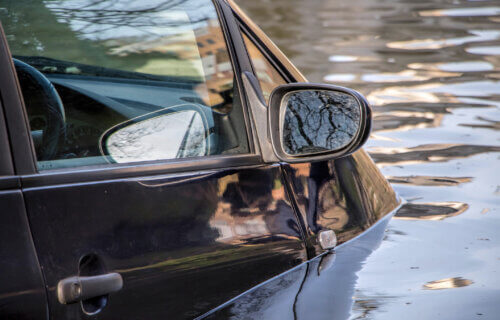Pure shock. That’s what I recall when I woke up and quickly learned that the Francis Scott Key Bridge in downtown Baltimore collapsed — just a short drive from my office. Video of the massive container ship losing power and then crashing into a support beam, causing the entire bridge to crumble almost instantly, was replayed over and over again on the news. Though police miraculously were able to halt traffic moments before the collision, six construction workers on the bridge lost their lives, their vehicles plunging into the freezing waters of the Patapsco River.
Before figuring out the logistical nightmare of my typical commute to my law firm in Charm City, I asked myself what would I have done if I were on that bridge with my family when it collapsed. Would I have known what to do? Would you know what to do? I remembered getting a combination hammer and seat belt cutter as a stocking stuffer for Christmas years ago, but I had no idea where it was. Even if I knew where it was, would it even work? The answer is no, I recently learned.
In a 2019 study, AAA tested the most common escape tools sold on the market for emergency underwater use and found that only spring-loaded tools such as the resqme Original Emergency Keychain Car Escape Tool could shatter tempered glass of a car. The hammer style tools failed all attempts to break vehicle glass. Thanks for nothing, Aunt Louise (JK, I still love you and the pink mini toolkit you gave me last December).
If I am honest with myself, if it were me on that crumbling bridge, of course, I would have been in a state of total panic, trying desperately to find the apparently useless hammer tool as I faced certain death. I would not know whether to open the windows or doors to immediately escape or avoid creating openings where water would get in. I would be paralyzed by fear in that state of shock and confusion. Do we unbuckle ourselves and try to get out, or stay in the car and wait for help? One of the kids would probably be opening a door while my husband would be screaming at him to keep water from coming into the car. The indecision and lack of coordination could be devastating.
JUST IN: Maryland officials have confirmed the retrieval of two bodies from a submerged red pickup truck near the Francis Scott Key Bridge. So far, the victims of the bridge collapse hailed from Mexico, Guatemala, El Salvador, and Honduras, according to officials. pic.twitter.com/MpARELS8L3
— Simon Ateba (@simonateba) March 27, 2024
Dark? OK, yes, a little. This article is not your therapist’s blog on mindfulness techniques. This article is meant to address unplanned experiences, such as a bridge collapsing under your car, and what you should do to maximize your chance of survival. A little clarity could go a long way should you end up in one of these tragedies. It’s important knowledge that can help you do your due diligence before any such event, and will hopefully encourage you to discuss the plan with your family.
And who am I to tell you what you can easily research yourself? Am I an expert on optimal escape strategies for families stuck inside a car that has fallen off a bridge? Did I find the long-lost “MacGyver” episodes about breaking underwater car glass on VHS in my parents’ basement? Sadly, no (but hint-hint, Aunt Louise, for next Christmas!)
Actually, I am just your run-of-the-mill corporate law firm partner who spends her weekdays assessing risk and structuring mergers and acquisitions for businesses. I am also a mom of four young children who spends her weekends carpooling kids to activities and playdates (while dreaming of finding a Saturday night babysitter who shows up on time before a date night.)

So, what makes me uniquely qualified to offer this unsolicited nonlegal advice? Really nothing except my lifelong passion (ahem, obsession? compulsion?) in figuring out what to do in life situations that I did not plan or expect. Since I was pregnant with my first child, I have spent more time reading studies and researching “what ifs” than I care to admit. In that sense, I consider myself a professional “concerned mom.”
So what did my lawyer-mom OCD-like research skills come up with?
Are You Prepared For A Water Emergency In The Car?
Here’s what I learned to do if my car surprisingly ends up in a large body of water. Let’s first take a beat to cover preparation. Every car should have a combination seatbelt cutter and spring-loaded glass breaker (NOT a hammer) in an easy-to-access location. The resqme tool can attach to a keychain or the rear-view mirror for easy access. According to Greg Brannon, director of Automotive Engineering for AAA, in discussing the 2019 AAA study on underwater escapes, “Drivers should pick a tool they feel comfortable with and find easy to use, but most importantly, they should store it somewhere that is secure and within reach following a collision.”
You should also figure out ahead of time the type of glass your vehicle windows are made of, whether tempered or laminated, so you know which one to break in an emergency. If your car has at least one tempered window, this will be the best point of exit in a water emergency. Laminated glass will not break, even with a AAA-recommended escape tool. Most sunroofs and rear windows are tempered.
To figure out what kind of glass is in the side window of your car, you can look in the bottom corner to find the label. If you cannot find the label, you can roll down the window and look at it from a bird’s-eye view. Smooth and one piece is usually tempered, while a sandwich shape with a ridge (like the front windshield) is laminated glass.
If you have small children who cannot swim, you should also consider having a flotation device in the car, such as a swim bubble, or child-size life vests under the seats. I also recommend putting an Apple AirTag or similar locator in each car to track the exact location of your car. Obviously, if you see an unstable bridge or road or an event that could make it unstable, do not go on it. Also, bridges get icy before roadways, and they are more susceptible to flash floods. So if there is snow or sleet or sudden, strong rain, avoid the bridge on your drive if you can.
What To Do After The Car Plunges Into Water
Now, let’s say you are driving on the Chesapeake Bay Bridge on a bright summer day on your way to peaceful Bethany Beach from Baltimore, drowning out your lovely screaming, fighting kids while belting Taylor Swift classics (just me?) when the bridge suddenly starts to collapse. Hopefully, you are not one of the 80% of parents (like me) who experience car seat hassles with their kids causing dangerous driving habits!
But in any event, take a deep breath, stop your car, make sure everyone’s seat belts are on, and unlock any child lock or window lock. Tell everyone to brace for impact and keep their heads forward, experts suggest. Easier said than done, but again, knowledge is key. Once your car makes contact with the water below, immediately prepare to get out of the car. You will have between 30 and 120 seconds before the car starts to sink, which is plenty of time to escape.
Everyone should unbuckle their seat belts (if you cannot unbuckle a seat belt, use the cutting tool), then open all the windows. Open the sunroof if you have one. Do not open the door as it will cause water to flood in rapidly, making it very hard to exit and allowing the car to sink even faster.
If you cannot open the windows, try to break a window using the spring-loaded tool on tempered glass, such as your sunroof. Everyone should attempt to exit through their own window if possible or at least the closest window to them. GET OUT OF THE CAR. Of course, help any children who are in car seats or otherwise need assistance.
Swim to safety if possible or tread water and wait for help. If you are in cold water, do not remove clothes or shoes as they can provide some thermal protection and only swim if you are very close to the shore (otherwise, you will lose valuable heat and hypothermia sets in quicker with exertion, studies find).
OK, that concludes my first-ever installation of potentially cheating certain death by your friendly corporate lawyer on StudyFinds. Back to your regularly scheduled programming. May you never have a need for a spring-loaded glass breaker for an underwater car rescue, but keep one in your car just in case. It makes for a nice mirror accessory if I do say so myself.
And if you do end up driving on a bridge that collapses into freezing water, remember to pray. Really. It helps. Also, know that this is not legal advice, so do not rely on it to stay alive.

Good article but shattering glass isn’t opening the glass although the glass will shatter you still may not be able to get out because it will not open a space for you to do that so it’s important and I’m just learning these things myself so thank you for the article